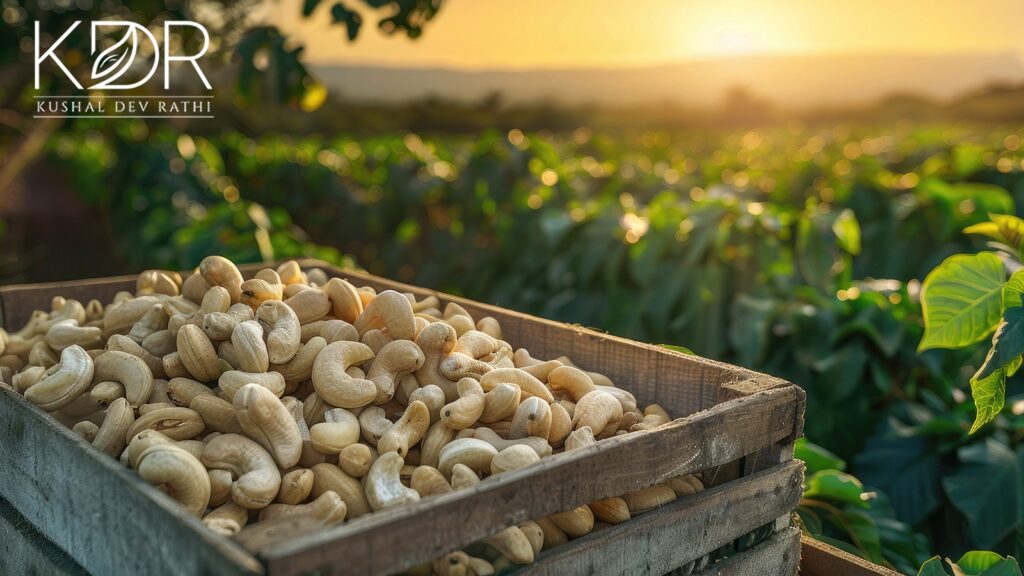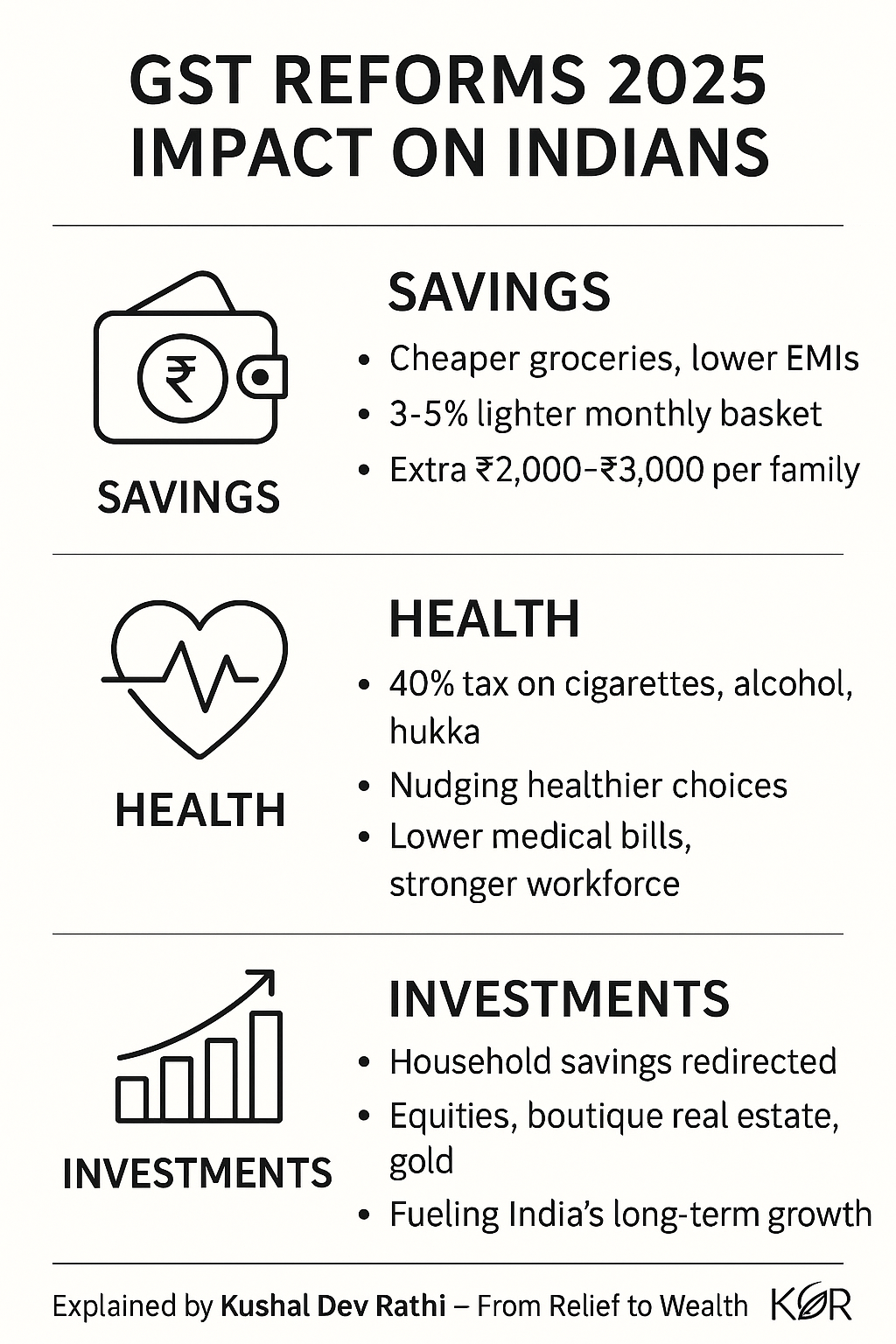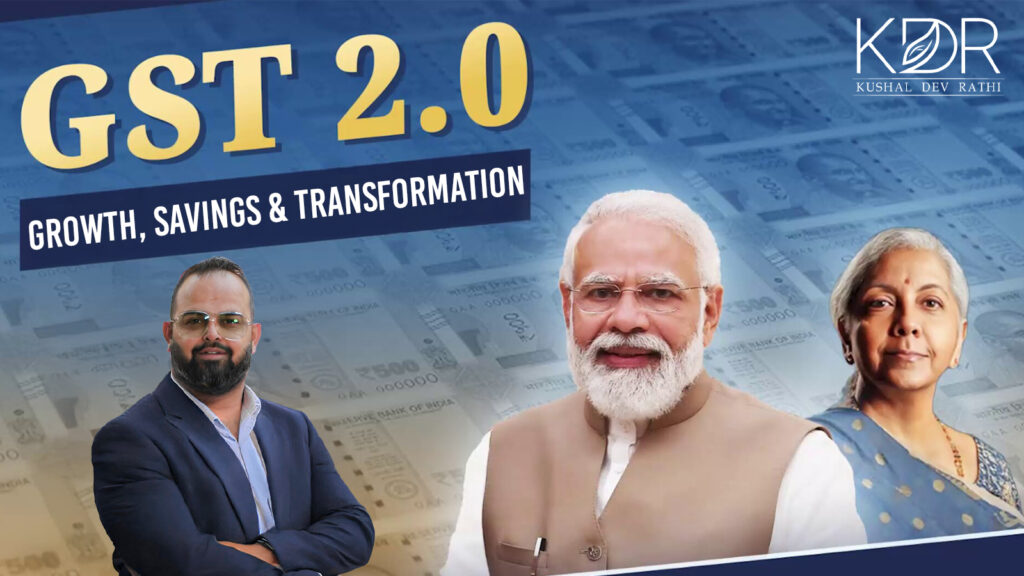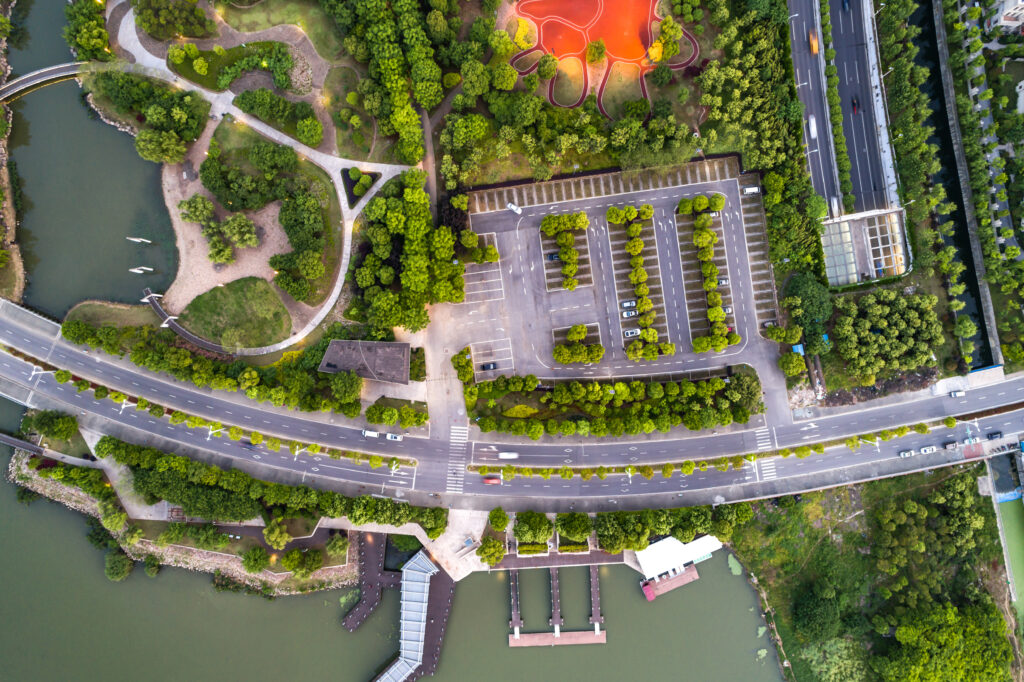The Weekend That Opened My Eyes
And finally… the weekend had arrived.
Like most city professionals, I had planned to relax, unwind, maybe check off a few small “to-do’s” while pretending to recharge. But this weekend was different.
I found myself holding a basket of spinach, coriander, guavas, and mangoes — all grown on land I owned, yet had never once ploughed, watered, or weeded myself.
The spinach crunched with an earthy freshness I hadn’t tasted in years. The guavas were sweet, sun-kissed, and alive with flavor. Every bite carried a strange satisfaction — not just of eating, but of belonging.
But here’s the irony: I live in a city, inside a VIlla, where even my money plant struggles in an 8-inch pot. My weekdays are mechanical, my weekends are usually reduced to Clubbing , Pubbing , Netflix, scrolling, or errands.
So how was I now enjoying produce from my farm?
The answer: collaborative managed farmland.
This wasn’t just about fresh food. It was about an asset that connects health, wealth, and legacy in one ecosystem. As I enjoyed that weekend feast, it struck me: what I was tasting wasn’t only food. It was foresight.
This was a glimpse of the next big wealth opportunity for Indians in the 2020s.
Why Farmland, Why Now
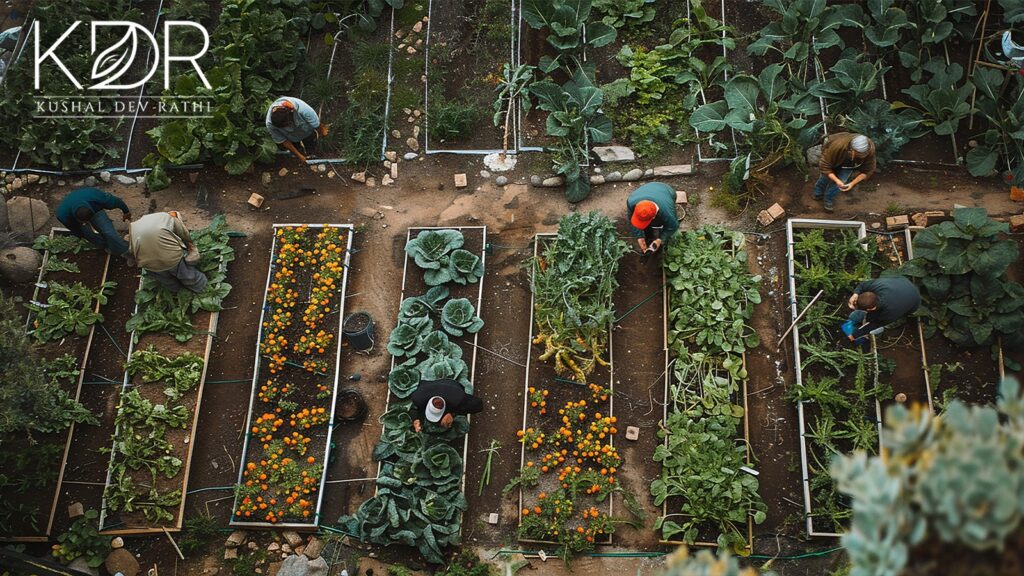
India’s relationship with land is centuries old. Land has always been the foundation of wealth. Our grandparents built legacies with farms. Our parents built theirs with apartments. My generation turned to equities and startups.
But the spotlight is shifting again — back to farmland. And this time, it’s smarter, structured, and scalable.
Rising Land Appreciation
- According to the Knight Frank India Farmland Report 2023, agricultural land in Maharashtra and Goa has appreciated by 10–12% annually over the past decade.
- Compare that to urban apartments in major metros, which have seen only 4–6% annual growth.
Urban housing markets are saturating. Farmland, in contrast, remains finite and in demand. In wealth terms, fertile land is appreciating faster than concrete.
The Food Demand Explosion
- India will need 50% more food by 2050 to feed its projected 1.6 billion citizens (FAO).
- Arable land per capita in India has fallen by 35% since 1980 (World Bank).
- Demand-supply imbalance is inevitable.
Farmland is no longer just an asset. It’s critical infrastructure.
Global Wealth Moving Into Farmland
Globally, farmland is already established as a hedge for the ultra-wealthy.
- The NCREIF Farmland Index shows U.S. farmland delivered 11% average annual returns over 20 years — outperforming equities and bonds.
- Bill Gates is now the largest private farmland owner in America.
- Pension funds, BlackRock, and sovereign wealth funds are quietly allocating capital into farmland as an inflation hedge.
India is next. And those who see it early will benefit most.
The Urban Dilemma
For most city dwellers like me, the idea of owning farmland always felt like a dream that belonged to someone else.
We live in concrete jungles. Our daily view is glass towers, not fields. Every inch of city land is monetized, leaving no space to breathe.
We order groceries in 10 minutes. It’s efficient, but it disconnects us from reality. Our children grow up believing food comes from apps, not soil. For them, “farm-to-table” is a restaurant theme, not a lived truth.
The fantasy of farmland always collapsed under practical questions:
- Who will manage the farm?
- How will we find trustworthy labor?
- What about irrigation, soil health, compliance?
- And most importantly: where’s the time?
Farming meant sweat, uncertainty, and walking away from urban careers.
So, we resigned ourselves to two categories of farmland owners:
- Traditional farmers.
- Billionaires with estates.
For the rest of us, it was out of reach.
Until now.
Collaborative Managed Farmland Explained
Collaborative managed farmland solves the dilemma.
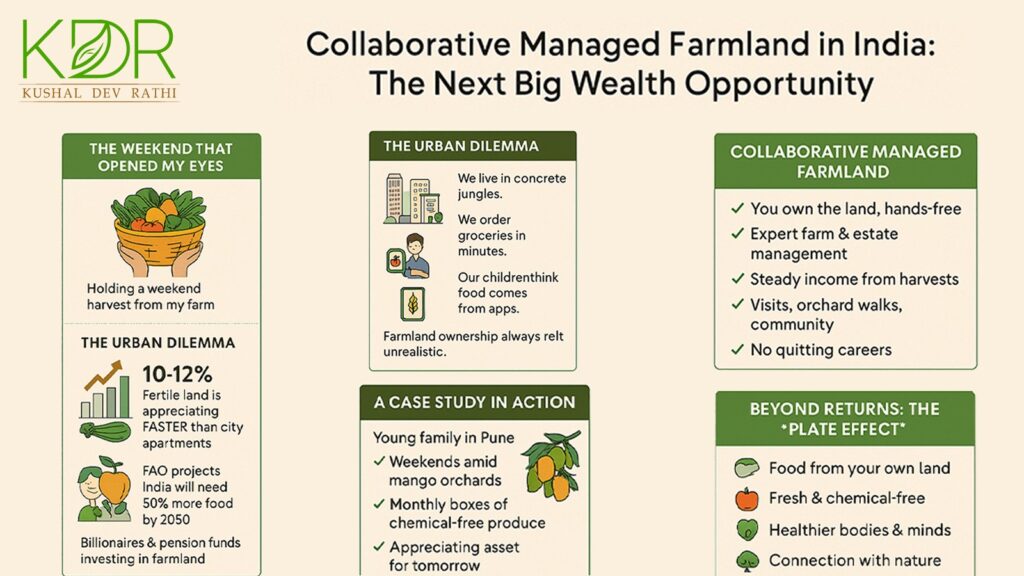
Here’s how it works:
- ✅ Ownership: You own titled farmland. It’s legally yours.
- ✅ Professional Management: Experts handle soil testing, irrigation, crop planning, compliance.
- ✅ Produce: Fresh, chemical-free harvests delivered to your home.
- ✅ Wealth: Land appreciates steadily while offering potential farm income.
- ✅ Lifestyle: Weekend visits, orchard walks, community events — without leaving your career behind.
Think of it as- FARMING , WITHOUT FARMING
It’s collaborative because multiple owners are part of a larger farming estate, enjoying economies of scale, shared facilities (farmhouses, cafés, farm-to-table kitchens), and professional oversight.
This structure unlocks farmland for urban professionals:
- No risk of abandoned or mismanaged land.
- No shady middlemen.
- No need to live like a farmer to enjoy farming’s benefits.
It’s the perfect hybrid: farmland as an investment + lifestyle + legacy.
Case Studies in Action
Family in Pune
- On weekdays → managed by agrotech professionals.
- On weekends → the family drives down; kids run in orchards, parents reconnect with nature.
- Every month → they receive vegetables, fruits, even cold-pressed oils.
For them, it’s not just ROI. It’s about lifestyle and legacy.
NRI Investor in Dubai
- An NRI professional invests in Goa farmland.
- Gains rupee appreciation + dollar hedge.
- Farm visits become family holidays, produce shipped to relatives in India.
For him, it’s not just land. It’s identity and reconnection with roots.
Retired Couple in Bangalore
- Instead of buying another flat, they invest in managed farmland.
- Enjoy peaceful weekends, community living, and farm-fresh meals.
- Pass the land on to their children as a legacy.
Every decade has a defining wealth asset:
- 2000s → Apartments.
- 2010s → Equities and startups.
- 2020s → Farmland.
Farmland vs Traditional Assets
Asset Class | Avg Annual Return (India) | Volatility | Legacy Value | Utility |
Urban Apartments | 4–6% | Medium | Yes | Lifestyle only |
Equities | 12–15% | High | No | Pure financial |
Gold | 8–9% | Medium | Yes | Hedge asset |
Farmland | 10–12% (land + produce) | Low | Yes | Food + wealth |
(Source: Knight Frank, NCREIF, NSE India)
Why Farmland Excites Me as a Strategist
- Limited Supply: Apartments can go vertical. Land cannot.
- Dual Returns: Value appreciation + produce income.
- Low Volatility: Farmland is less impacted by market shocks.
- Legacy Value: Unlike equities, farmland passes down generations.
Portfolio Allocation Strategy
- Retail investors: 10% allocation.
- HNIs: 15–20%.
- NRIs: 10–12% (hedge against currency).
Farmland isn’t about fast flips. It’s about silent compounding. By the time it becomes mainstream, early adopters will already hold the best plots.
Beyond Returns: The Lifestyle Dividend
Numbers aside, collaborative farmland offers the plate effect.
When meals come from your own land, every bite feels different.
- Your children learn where food comes from.
- Your weekends shift from malls to orchards.
- Your health improves with chemical-free produce.
- Your mind benefits from space, silence, and green.
A Harvard study shows people with regular access to green spaces live longer and healthier lives.
In a hyper-urban world, that reconnection is priceless.
Sustainability & The Bigger Picture
Farmland isn’t just personal wealth. It’s national resilience.
- India’s organic food market is growing at 25% CAGR, expected to reach $4 billion by 2030 (ASSOCHAM).
- Collaborative farms reduce chemical usage, conserve water, and promote biodiversity.
- They create rural jobs, support local supply chains, and boost India’s food security.
According to the UN Environment Programme, sustainable agriculture is now a $1 trillion global opportunity. Collaborative farmland ensures urban capital flows into rural growth — bridging the gap between cities and villages.
This is wealth that gives back: to you, your family, and your country.
Frequently Asked Questions (FAQs) on Collaborative Managed Farmland
- What is collaborative managed farmland?
It’s a model where you own titled farmland, but professional experts manage everything — from soil testing and irrigation to crop cycles and compliance. You get the produce, land appreciation, and lifestyle benefits without the stress of farming yourself.
- Why is farmland considered the next big wealth opportunity?
Farmland is finite, productive, and inflation-proof. In India, farmland values in states like Maharashtra and Goa have appreciated 10–12% annually (Knight Frank, 2023). Add rising food demand (India will need 50% more by 2050, FAO), and you get an asset that offers both appreciation and utility.
- How does farmland compare to other asset classes like gold or real estate?
- Urban apartments: 4–6% CAGR, lifestyle only.
- Gold: 8–9% CAGR, hedge but no utility.
- Equities: 12–15% CAGR, volatile, no legacy value.
- Farmland: 10–12% CAGR + fresh produce, lower volatility, generational asset.
- Is this suitable for NRIs and HNIs?
Yes. NRIs often invest in managed farmland for rupee appreciation and as a lifestyle/legacy asset. HNIs prefer it for diversification — allocating 10–15% of their portfolio into farmland as a hedge against inflation.
- Can collaborative farmland generate income apart from appreciation?
Yes. Depending on the model, owners may share profits from the sale of harvests (fruits, vegetables, oils). The real kicker, however, is dual returns — steady appreciation in land value plus potential farm income.
- What are the lifestyle benefits of owning farmland?
- Access to organic, chemical-free produce.
- Family weekends at the farm.
- A healthier, nature-connected lifestyle for kids.
- Emotional ROI: the “plate effect” — meals from your own land taste better.
- How does collaborative farmland support sustainability?
Managed estates promote organic practices, reduce chemical usage, conserve water, and create rural jobs. India’s organic food market is growing at 25% CAGR (ASSOCHAM), making farmland ownership aligned with future consumption trends.
Closing Thought
That weekend meal wasn’t just about flavor. It was about foresight.
Collaborative managed farmland is not a trend. It’s the convergence of three unstoppable forces:
- Rising food demand.
- Rising farmland values.
- Rising urban fatigue.
As a strategist, I don’t chase noise. I identify silent opportunities before they become obvious. And farmland is speaking — quietly, steadily, powerfully.
The only question is: will you listen before everyone else does?
To connect with me :

